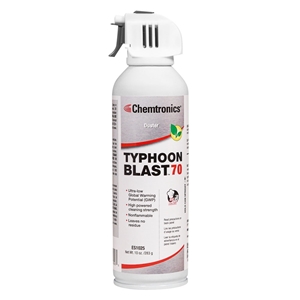
Typhoon Blast 70 Duster
Powerful and economical, ultra-low GWP duster with the BIGGER blast
Typhoon Blast™ and Typhoon Surge™ are the newest class of dusters from Chemtronics, specifically formulated to minimize the use of global warming compounds. They are formulated with HFO-1234ze, a new material that has a significantly lower global warming potential (GWP) than previous materials used for dusters. This new material has a GWP of less than 1, and compares very favorably to HFC-134a (GWP of 1300) and HFC-152a (GWP of 140). In addition, since it has a short atmospheric lifetime with a very low photochemical ozone creation potential, it is not expected to be classified as a VOC.
Features & Benefits
- Ultra-low Global Warming Potential (GWP)
- High powered cleaning strength
- Nonflammable*
- Zero VOC
- Safe on plastics
- Filtered to 0.2 microns
- Leaves no residue
- 100% HFO-1234ze
- Safe on plastics
* under ambient conditions
Applications
- Removing dust build up from circuit boards
- Cleaning insulating debris from pin connectors
- Removal of entrapped solvent from under surface mount devices
| TDS | |
| REGS | |
| SDS | |
| Categories |
| Shelf Life | 10 yrs. from production |
|---|---|
| Shipping Name | Cleaning Compound |



